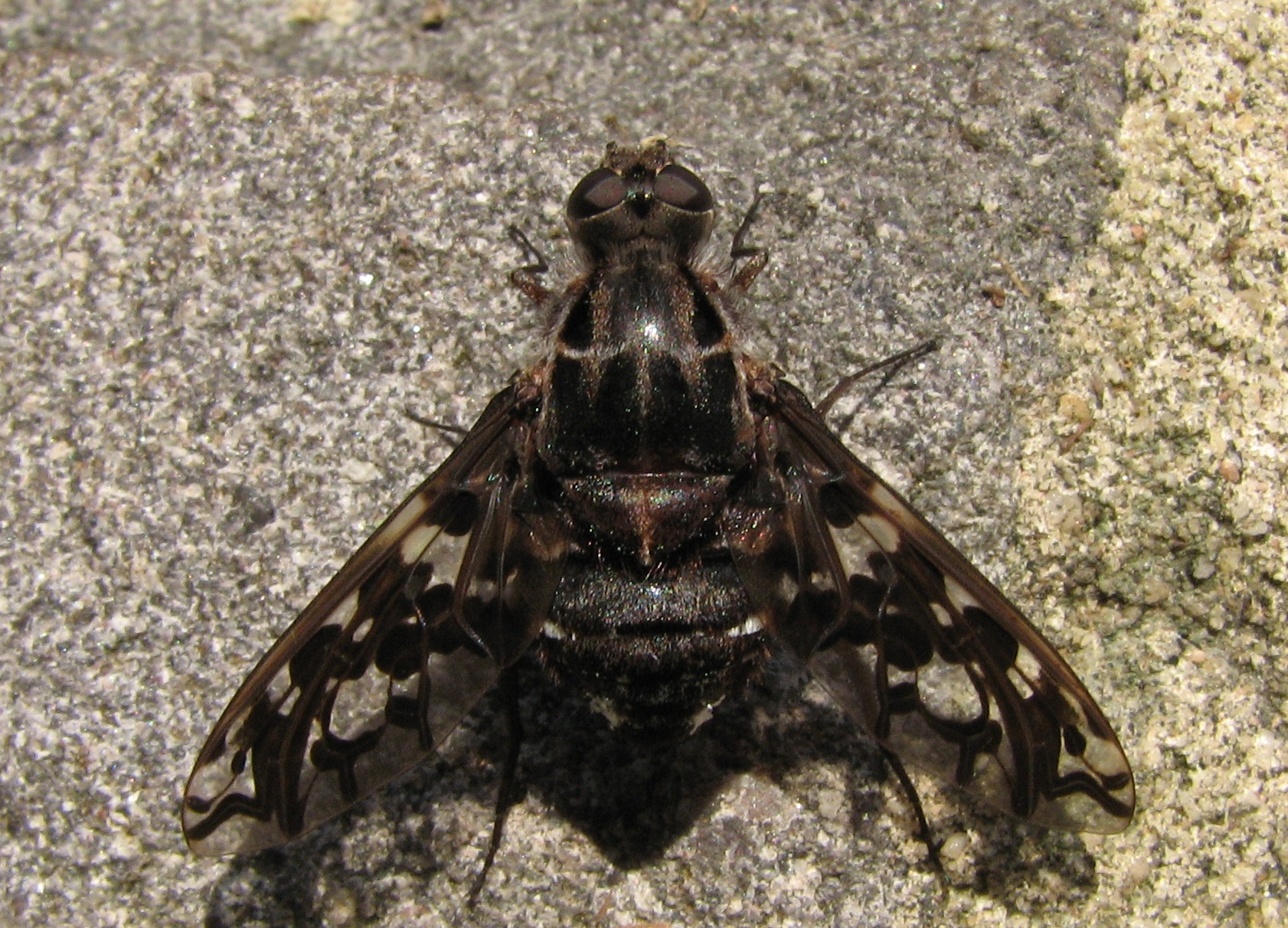|
Exoprosopa Jacchus
''Exoprosopa jacchus'' is a species of 'bee flies' belonging to the family Bombyliidae subfamily Anthracinae. Commonly named 'silvery bee-fly', this species is present in most of Europe Europe is a large peninsula conventionally considered a continent in its own right because of its great physical size and the weight of its history and traditions. Europe is also considered a Continent#Subcontinents, subcontinent of Eurasia .... The average body length of the adults reaches . The head and the thorax are dark-brown. The thorax is quite hairy and marked by silvery-white scales. The abdomen is blackish with a few silver hair stripes and it is hairy on the sides. The wings are mottled light and dark-brown, with hyaline patches on the front border cell (R1). The third segment of the antennae is longer than the fourth. References * Mark van Veen, Zeist Exoprosopa Keys External links BiolibFauna Europaea Bombyliidae Insects described in 1805 Diptera of Europe {{ ... [...More Info...] [...Related Items...] OR: [Wikipedia] [Google] [Baidu] |
Johan Christian Fabricius
Johan Christian Fabricius (7 January 1745 – 3 March 1808) was a Danish zoologist, specialising in "Insecta", which at that time included all arthropods: insects, arachnids, crustaceans and others. He was a student of Carl Linnaeus, and is considered one of the most important entomologists of the 18th century, having named nearly 10,000 species of animals, and established the basis for the modern insect classification. Biography Johan Christian Fabricius was born on 7 January 1745 at Tønder in the Duchy of Schleswig, where his father was a doctor. He studied at the gymnasium at Altona and entered the University of Copenhagen in 1762. Later the same year he travelled together with his friend and relative Johan Zoëga to Uppsala, where he studied under Carl Linnaeus for two years. On his return, he started work on his , which was finally published in 1775. Throughout this time, he remained dependent on subsidies from his father, who worked as a consultant at Frederiks Hospita ... [...More Info...] [...Related Items...] OR: [Wikipedia] [Google] [Baidu] |
Bombyliidae
The Bombyliidae are a family of flies, commonly known as bee flies. Adults generally feed on nectar and pollen, some being important pollinators. Larvae are mostly parasitoids of other insects. Overview The Bombyliidae are a large family of flies comprising hundreds of genera, but the life cycles of most species are known poorly, or not at all. They range in size from very small (2 mm in length) to very large for flies (wingspan of some 40 mm).Hull, Frank Montgomery, Bee flies of the world: the genera of the family Bombyliidae Washington, Smithsonian Institution Press 1973 . Downloadable from: https://archive.org/details/beefliesofworl2861973hull When at rest, many species hold their wings at a characteristic "swept back" angle. Adults generally feed on nectar and pollen, some being important pollinators, often with spectacularly long proboscises adapted to plants such as ''Lapeirousia'' species with very long, narrow floral tubes. Unlike butterflies, bee flies hold t ... [...More Info...] [...Related Items...] OR: [Wikipedia] [Google] [Baidu] |
Anthracinae
Anthracinae is a subfamily of bee flies in the family Bombyliidae. There are more than 80 genera and 2,000 described species in Anthracinae. Genera *''Anthrax'' Scopoli, 1763 *'' Aphoebantus'' Loew, 1872 *''Astrophanes'' Osten Sacken, 1886 *'' Atrichochira'' Hesse, 1956 *''Balaana'' Lambkin & Yeates, 2003 *''Brachyanax'' Evenhuis, 1981 *'' Caecanthrax'' Greathead, 1980 *''Chrysanthrax'' Osten Sacken, 1886 *'' Collosoptera'' Hull, 1973 *'' Conomyza'' Hesse, 1956 *'' Cononedys'' Hermann, 1907 *'' Coryprosopa'' Hesse, 1956 *'' Cyananthrax'' Painter, 1959 *'' Defilippia'' Lioy, 1864 *'' Desmatoneura'' Williston, 1895 *'' Deusopora'' Hull, 1971 *'' Diatropomma'' Bowden, 1962 *''Dicranoclista'' Bezzi, 1924 *'' Diochanthrax'' Hall, 1975 *''Dipalta'' Osten Sacken, 1877 *'' Diplocampta'' Schiner, 1868 *'' Epacmoides'' Hesse, 1956 *'' Epacmus'' Osten Sacken, 1886 *''Eucessia'' Coquillett, 1886 *'' Euligyra'' Lambkin & Yeates, 2003 *'' Exechohypopion'' Evenhuis, 1991 *'' Exepac ... [...More Info...] [...Related Items...] OR: [Wikipedia] [Google] [Baidu] |
Europe
Europe is a large peninsula conventionally considered a continent in its own right because of its great physical size and the weight of its history and traditions. Europe is also considered a Continent#Subcontinents, subcontinent of Eurasia and it is located entirely in the Northern Hemisphere and mostly in the Eastern Hemisphere. Comprising the westernmost peninsulas of Eurasia, it shares the continental landmass of Afro-Eurasia with both Africa and Asia. It is bordered by the Arctic Ocean to the north, the Atlantic Ocean to the west, the Mediterranean Sea to the south and Asia to the east. Europe is commonly considered to be Boundaries between the continents of Earth#Asia and Europe, separated from Asia by the drainage divide, watershed of the Ural Mountains, the Ural (river), Ural River, the Caspian Sea, the Greater Caucasus, the Black Sea and the waterways of the Turkish Straits. "Europe" (pp. 68–69); "Asia" (pp. 90–91): "A commonly accepted division between Asia and E ... [...More Info...] [...Related Items...] OR: [Wikipedia] [Google] [Baidu] |
Insects Described In 1805
Insects (from Latin ') are pancrustacean hexapod invertebrates of the class Insecta. They are the largest group within the arthropod phylum. Insects have a chitinous exoskeleton, a three-part body ( head, thorax and abdomen), three pairs of jointed legs, compound eyes and one pair of antennae. Their blood is not totally contained in vessels; some circulates in an open cavity known as the haemocoel. Insects are the most diverse group of animals; they include more than a million described species and represent more than half of all known living organisms. The total number of extant species is estimated at between six and ten million; In: potentially over 90% of the animal life forms on Earth are insects. Insects may be found in nearly all environments, although only a small number of species reside in the oceans, which are dominated by another arthropod group, crustaceans, which recent research has indicated insects are nested within. Nearly all insects hatch from eggs. ... [...More Info...] [...Related Items...] OR: [Wikipedia] [Google] [Baidu] |


